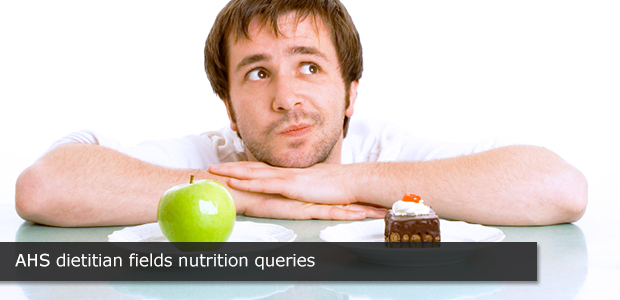Your healthy eating questions, answered

Everyone, even dieticians, have questions about healthy eating. Check out the video from our first ever Facebook Live event held on March 22 where staff and the public asked their burning nutrition and healthy eating questions. Thank you to all who joined!
If you missed our first event, then save the date and join our second Facebook Live Healthy Eating Q&A with me, Christine Fletcher on March 27, 2 p.m. MST.
Here are some questions from participants in our first event.
Question: What are some simple nutrition tips for someone trying be healthier?
My top nutrition tip for health is to follow the plate method (Eat Well Plate) for most of your meals.
Make vegetables and fruit the main focus of your meals. Fill about half of your plate with one or more vegetables or fruits. By doing this, you will be on your way to getting the 7-10 daily servings recommended for adults. Eating enough fruits and vegetables may reduce your risk of heart disease, stroke and certain types of cancer
Choose a smaller amount, about a quarter of your plate, of whole grains such as barley, brown rice or quinoa. Whole grains are more nutritious than refined grains such as white bread, rice or pasta.
The last small quarter of your plate is reserved for protein rich foods such as fish, legumes such as chickpeas, lentils, beans, tofu, eggs or meat. Getting enough protein rich foods is important for overall health and especially your immune system.
Question: I have low iron and take a multivitamin to help, but what are some foods that I can eat to increase my iron intake?
While your multivitamin is a great first step, there are a couple other food options that can increase your iron intake.
Try meats, poultry and fish, or eggs, legumes and spinach. For myself, a go-to favourite is this chili recipe. The vitamin C in the tomatoes will help your body absorb the iron in the meat and beans. You can also check out this Iron and Your Health PDF available on the AHS website for some other food options.
Question: My doctor told me to eat less salt, how do I do this?
We know too much salt is harmful for your health and it’s a good idea to be aware of how much salt you are eating. One part of salt is sodium, which is the word you see on the nutrition facts table. In general, Canadians eat more than twice the amount of sodium than is recommended. Most of the sodium we eat comes from processed foods, packaged foods and restaurant foods.
The daily limit of sodium is 2300mg. To know how much sodium is in a meal, review the nutrition facts table on any packaged foods.
Some tips to reduce sodium are:
• Eat less processed packaged and restaurant foods
• Choose fresh, unprocessed and homemade foods more often
• Read food labels and buy foods with less sodium per serving
• When cooking at home, flavour your foods with herbs, spices, lemon juice and vinegar and less salt
Question: The 3 p.m. lull hits me every afternoon and I end up grabbing foods that are not necessarily the healthiest option. What can I eat to help me through the inevitable energy dip?
I completely understand where you are coming from with your comment about the 3 p.m. energy dip. I struggle with the same challenge.
Here are a couple of options to help starting with trying to keep some healthy options easily available at work. This could be nuts or trail mix, whole grain crackers, a fruit cup, or piece of cheese or fruit - like an apple - that you can bring with you.
Question: I’m trying to cut back on coffee, what else can I do to stay awake at work?
To cut back on caffeine, you may want to reduce your intake slowly. If you cut it out quickly or “cold turkey” you may have unpleasant side effects like a headache or difficulty concentrating.
To slowly reduce number of cups gradually space out the cups of coffee and eliminate your last one. For example, if you usually drink 5 cups per day, start by drinking 4 cups spread slowly over the time you would normally drink 5. Once you’re ready, reduce by one more cup. Continue this until you have reached your goal.
Replace coffee with other drinks. Try drinks that have less caffeine. For example, decaf coffee, ½ decaf (mix regular coffee with decaf coffee), or caffeinated tea (like earl grey or orange pekoe), are all great options.
Save the date! Join our Facebook Live Healthy Eating Q&A with Christine Fletcher: March 27, 2 p.m. MST. Have a nutrition or healthy eating question? Leave a comment below or email it in advance to wellness@ahs.ca. During the Q&A, Christine will also offer tips and advice to create and maintain healthy eating habits for all ages.
Please note: we can’t answer questions that include too much personal health information. For medical advice, contact your physician or call Health Link by dialing 811 to speak with a registered nurse 24/7.
Join the conversation, and be inspired to think about your wellness!
Share what balance looks like to you, using #AHSwhatsyourbalance on social media. Or visit www.ahs.ca/whatsyourbalance to download the Wellness Scorecard to get started on your path to finding balance.
Disclaimer:
Please note the ‘What’ your balance?’ blog posts are views of the authors only, and should not be considered as formal advice and instruction. Readers should consult with appropriate health professionals or dial 811 for Health Link on any matter related to their health and wellbeing.










